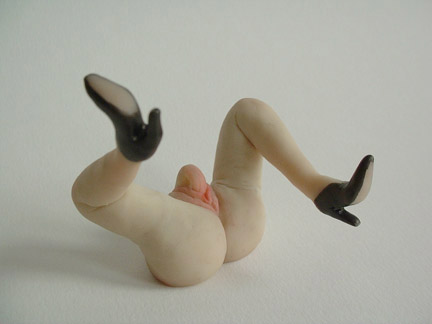 . . . . . . . . . . . . . . . . . . . . . . . . . . . .
. . . . . . . . . . . . . . . . . . . . . . . . . . . .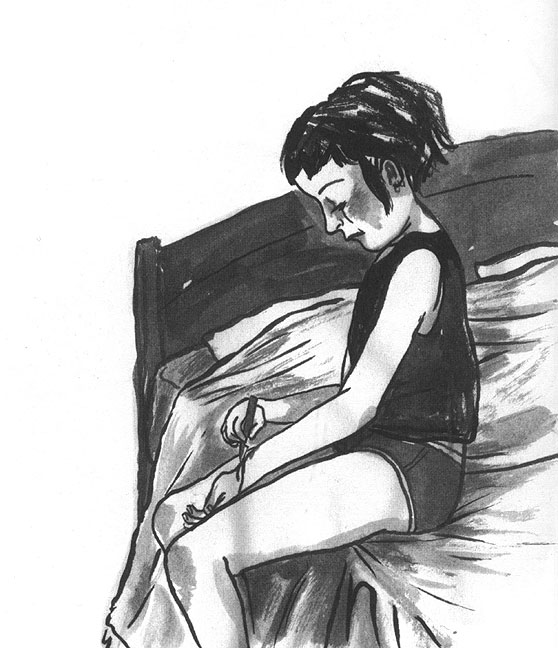
Fig. 1: untitled. polymar clay, gouache, 6cm tall (Boyle, 2002). . . . . . . . . . . . . . . . . . . . . . . . . . . . . . Fig. 2: untitled. ink (Boyle, 1999).
Looking at Freud’s
Uncanny and Seeing the Feminine:
A Reading of das Unheimliche Via the Visual With the Help of Artist
Shary Boyle.
Gayle Gorman, 2006
The writer of the present contribution, indeed, must himself plead guilty to a special obtuseness in the matter, where extreme delicacy of perception would be more in place. It is long since he has experienced or heard anything which has given him an uncanny impression, and he must start by translating himself into that state of feeling, by awakening in himself the possibility of experiencing it.
But I must confess that I have not made a very thorough examination of the literature, especially the foreign literature, relating to this present modest condition of mine, for reasons which, as may easily be guessed, lie in the times in which we live… (my italics, Freud, 1919: 220)
What would Freud think of the Uncanny – Unheimliche – were he alive today? Would he find it any easier to experience? Would the image-saturation of our current postmodern culture turn him towards the visual in experiencing and formulating the Uncanny? Why does it take an ‘extreme delicacy of perception’ to experience the Uncanny, and why is Freud’s own perception lacking this gentle nature, this fragility? How, then, may the Uncanny be related to contemporary post-psychoanalytic ideas of what constitutes the feminine?
These questions are important to me as I set out to bring something new to Freud’s
unheimliche, which has certainly been confronted many times and through varied
lenses; my own preference is for an emphasis on the visual, for the empirical
dictum of seeing-is-believing, for sight-as-knowledge, in that knowledge is
never certain just as appearances can be deceiving, which is what causes me
to raise some of these questions, questions that come out of what is omitted
from Freud’s 1919 essay das Unheimliche (The Uncanny), as any
properly psychoanalytic reading requires. Through my research I embrace Hélène
Cixous as she employs this turning and twisting to Freud’s essay in her
response essay Fiction and Its Phantasms: A Reading of Freud’s Das
Unheimliche, as she engages enthusiastically and emphatically with his
writing and thinking in a resistant response and interaction. In doing so I,
unavoidably it seems, come to issues of binaries and feminine sexuality, thus
inviting into my attempt the profound ideas of Luce Irigaray as a counterforce
to the phallocentric normalcy of psychoanalysis. In deploying this feminine
sexuality and my own feminine reading of das Unheimliche, I look at
the visual artwork of Canadian artist Shary Boyle and her creation of a pre,
or non, Oedipal world where desire may flow unrestricted by the constraints
of the symbolic order.
Attraction:
If one is attracted to the writings and ideas of Sigmund Freud, one would think
that one would also be drawn to his concept of the uncanny, for the built-in
ambiguity and undefinability of the term sits well within the legacy of psychoanalysis
itself as being concerned with this very space of in-between what we know and
what we don’t. Shoshana Felman states (1987: 57) that "Freud’s
unprecedented discovery’ was that the unconscious was not simply opposed
to the conscious mind, but ‘speaks as something other from within the
speech of consciousness itself". This "something other" is not
only our unconscious mind, but the inexplicable as a site of inquiry, and inquiry
as a citing of the self. The other of Otherness, something between what’s
known and what is not, is where both psychoanalysis and the uncanny live and
we are drawn to this "province" of the repressed because we are drawn
to the unknown through our desire to know. Consciousness "turns out to
be forever incomplete, illusory, and self-deceptive" (Felman, 1987: 57),
all words that can (im)properly fit within the domain of the uncanny.
We shall be guided by the ambivalence and in conformity with the undecidable
nature of all that touches the Unheimliche: life and fiction, life-as-fiction…
(Cixous, 1975: 526).
The uncanny’s contemporary popularity, as almost its own genre both academically and artistically, is found in the Gothic and the Horror and finds itself Fantastical and manifested in Sci-Fi via the cyborg; it is indelibly cross-disciplinary, multifaceted, and at home in fiction that easily allows for belief to be suspended and the repressions of the unconscious to come to the fore. In Freud’s analysis the experiencing of the uncanny was possible primarily via the written word, in literature such as E.T.A. Hoffman’s story The Sandman, which he examined and interpreted in The Uncanny in an attempt to define the term and understand its solicitation as an affective response. Are we not now closer to the experience of the uncanny via the postmodern condition and the ubiquity of moving images as a display of our collective unconscious – the realm of our vast repressions? Is the uncanny, as set within the frightening, not one of our more desirous of cultural products today in an age when re-presentation casts such enigmatic virtualities as believable within the safety-net of vicarious experiences, when fear itself is a commodity to enjoy without fear? For the uncanny today is seen as a way to bring notice to our cultural unconscious, whether via architecture or horror films. We seek explanations and it is in this seeking that we find what’s been buried, where we excavate the ruins of our past and apply them to our present state. The uncanny affords us the opportunity to experience knowledge as something that is not pre-determined or easily given, knowledge that is based in an affective response that flies counter to reason.
In reading das Unheimliche I cannot help but linger on the lack of
attention given to the act of seeing, to the idea of sight-as-knowing, especially
in Freud’s re-telling and analysis of The Sandman. Freud lived
during a bursting of Modernity and how he could not have written about photography
and cinema is a question left wide open for me in my questions of the sight’s
invisibility in his essay. Since Freud, of course, much has been written on
the uncanny nature of photography and especially on its initial effects on people
first apprehending it, and on its relation to death (Sontag, 1973; Barthes,
1982; Cadava, 1997). The familiar-yet-unfamiliar experience of the Lumiére
Brother’s pivotal film of a train entering a station was certainly something
that Freud was aware of and must have, to some degree, experienced himself.
What of skyscrapers? What of the automobile? This uncanny element of time and
space compression that Paul Virilio (1984, 1991) is so versed at theorizing
about today was actually transpiring in its infancy during the time that Freud
was creating his science of psychoanalysis via the rise in a Modernist sensibility
and the work of artists such as the Italian Futurists. Perhaps it was his entrenched
petite bourgeois perspective that kept such novelties from the interior of the
human psyche and of his own for Freud, leaving time-based media to all the others
who have come since, though he certainly acknowledged that dreams were primarily
manifested as imagery and spatial experience.
Hindsight:
… it seems as though that major strand of ‘indeterminacy’
in postmodern theory that Ihab Hassan has termed ‘the unrepresentable’
is entirely preoccupied with the uncanny in many implicit and explicit ways
(Arnzen, 1997: 2).
In hindsight postmodernism gives us the ability to condition ourselves as negotiators
of a world founded on uncertainty and illusion. Had Freud actually lived to
have witnessed the Holocaust and its aftermath, then perhaps he may have been
so conditioned. As it was, his theory of the death drive, which emerged from
case studies of shell-shocked World War I soldiers, set him on that path and
set us, who come after him, on the path to postmodernity. Had he lived long
enough (he died in 1939 barely a year after fleeing Austria) to know that his
dear sisters had been killed in Nazi concentration camps, would he have revised
his work even further? The splitting between modernity and postmodernity that
was exemplified in Auschwitz was foreseen by Freud in his theoretical move from
pleasure to pain, from the individuals’ psyche to that of society’s,
and the need for a father-figure to embody the laws of civilization. Had he
survived his cancer to witness the machinizations of progress as made into death
camps, would it have told him anything that the technological applications of
World War I already hadn’t?
"The more you try to bury the dead, the harder they whisper", writes Alex Demeulenaere (2003: 4). Since the Holocaust our ever-present shared anxiety has grown like weeds in the already-corrupted garden, now being so entangled in their origins as to be unnamable and their sources almost imperceivable: "the unspecified tensions of everyday experience" (Berteen, 1995: 62), since everyday experience is so layered with pathological angst. The postmodern subject is imbued with the underbelly of human motivations, and the postmodern society strives to keep the engine of illusion working to sustain a livable level of healthy ignorance, just as it provides for the plurality of deviance and worms beneath the surface of things: "Freud is one of the great disturbers of purity… In the Freudian model, the impure manifests itself not in some other space but as a disruption to any pure realm" (Gallop, 1988: 34), such as a realm of metaphysical distinction that prefaced the postmodern turn. The collapse of master narratives, such as the belief in technological progress making our lives more livable, resulted in a blending and blurring and the creation of multiple spaces between: between people and between what we know and don’t know. Freud helped us too in thinking about space as a psychic entity: the ‘province’ of the uncanny, the "dark continent" of woman. Thus we are mired in uncanniness, as Freud had not so easily been (‘the times in which we live’), as stated in the opening quotation. Yet, "Freud discovered close relationships among the various psychic productions: myths, tales, literature, and art can be explained like dreams" (Kofman, 1988: 3). His method of dream analysis established
a [A] link between the unconscious and the conscious, the normal and the
pathological, the child and the adult, the civilized man and the primitive man,
the individual and the species, the human and the divine. It links cultural
and psychic productions, representations and affect, and so forth (ibid).
This link, this crossing-over and connecting, both establishes a space between
and de-establishes the linear causality that we had become accustomed to since
the Cartsian mind/body split. Freud knew that art was a way to get to this place,
that artists ("poets") had a way of knowing that sidesteps reason
and dispels binaries between childhood and adulthood in terms of imaginative
proclivity. Sarah Kofman writes in her interpretation of his aesthetics that
Freud felt that "what is true of art and religion and psychotic delusions,
namely the constraint imposed by the logical mode of thought, is no longer in
force" (15) for artists. In his paralleling of the individual to the human
species, Freud saw the artistic phase in a person as akin to the animistic phase
in early humankind: "the animistic phase must be surpassed by the scientific
phase – that of adulthood – characterized by renunciation of the
pleasure principle and subordination of object choice to reality" (20).
The child is a natural artist and privy to the animistic belief that all things
are full of lifespirit, that all life exists in the immaterial as well as the
material, that believability has more than vision to sustain itself. Closer
to a realm of pure affect (the Real), children embody forces that Freud characterizes
as uncanny, such as these beliefs, that allow for the flights of imagination
necessary for artistic production: "As children, we did not know if we
were going to laugh or cry but, as adults, we 'possess' this world, we make
endless use of it… we have forgotten, out of habit, our childish apprehensions"
(Bataille, 1949). "There is a rift, an unmastered gap or discontinuity
between consciousness and the unconscious, and infantile and adult sexualities",
(Grosz, 1990: 10). From child to adult, the division is an illusion of a clearly
marked path from one to another, rather than this discontinuity. Psychoanalysis
strives to define this porosity: "Freud observed that one of the main features
of the uncanny lies in a problematic relation with the past" (Demeulenare,
2003: 3). Hence, the uncanny in cinematic and literary examples sees itself
played out with narrative devices akin to methods of analysis, such as flashbacks,
overdubs, shifting points of views and multiple narrators, as means to address
the problematics of the experience of time.
In his essay of 1994, The Pictures Over Freud’s Couch, George
Dimock addresses the images and sculptures that Freud kept in his office in
Vienna, a space that was photographed by Edmund Engelman in 1938 on the night
Freud left Austria for good. Although Dimock does an exemplary job at analyzing
and connecting these works to psychoanalysis and to Freud’s personal and
professional history, I want to see if I can look into the sort of artwork,
aside from the written word of literature which seems to be what he meant most
of all by "art", that appealed to Freud and understand his aesthetic
leanings. The work, such as a reproduction of a painting by Ingres of Oedipus
and the Sphinx, seems to directly relate to Freud’s overt interests in
history and archeology; another image is that of an Egyptian mummy. Again, leaving
it to Dimock to attach significance to these images via Freud’s ideas
and fascinations, I strive to understand the appeal of the art for aesthetic
reasons, yet it doesn’t seem that Freud was interested in pictures other
than for what they studiously referenced, such as the classical history of the
West. There are no Impressionistic images, Japanese prints, or Art Nouveau muses,
as were the effete pictorial tastes of the day. So here I am left with not knowing
what other sort of imagistic art Freud might have been drawn to: Braque’s
cubist figures, Cézanne’s fragmented spaces, Monet’s hazy
lilies? What did he make of those, so revolutionary at that time?
I ask these questions, again, because of what is not included in his essay das
Unheimliche. In limiting his journey into an acknowledged aesthetic realm
to the written word, Freud is omitting so much of the power that the Uncanny
contains; he is perhaps avoiding being affected by it and thus not facing his
own repression, though his approach to the uncanny is admittedly uncertain,
as uncertain as I am in looking at his omission. By not citing sight as a trigger
for affect in his analysis, he depends on language that fails to elicit this
effect from himself, as attested to in the quote at the start of this essay.
Is his inability to be so impressed predicated on his indelicate perception?
Or can it be that the power of words has not the force of an image; that words
are indelicate compared to the fragility of a picture? In answering "yes,
both" to this question, I make the connection to the time in which he lived
as manifest in his own disposition; was Freud privy at all to the proliferation
of photographic pornography in Europe at this time? Was he so bourgeois as to
not attend to it in his theoretical work, as well as ignoring it in his own
desires? The critique of photography and cinema as being mere entertainment
‘for the masses’ at that time was perhaps part of the middle-class
mentality that had its hold on Freud. Can we vulgarly refer to this mentality
as uptight, especially if we are to cite Cixous’s response essay in pointing
out that sex is what Freud is leaving out of his own analysis: "It is only
at the end that the sexual threat emerges. But it had always been there latently"
(1975: 530).
Doesn’t the analysis which brings up the whole question of repression
imprint them at once upon the one who undertakes the analysis (526)?
Eyes:
In Thinking Through
The Body Jane Gallop calls attention to "the imprint of his own subjectivity
upon his pursuit of knowledge" (Gallop, 1988: 5), as she too calls attention
to the psychoanalytic critics’ analysis (her own and mine) as being engaged
in an ‘erotics of engagement’ with their own subject matter of choice
in which they choose to find themselves; desire to know and desire for sex is
of one and the same drive circuit. In das Unheimliche Freud uses the
story The Sandman to find a way to pinpoint the uncanny and ends up
conveniently running head-first into his castration complex. This is because
of the emphasis on eyes in the story, the main theme, according to Freud, being
the "Sand-Man" who tears out children’s
eyes” (Freud, 1919: 223). My own attraction is towards the visual manifestation
of the uncanny and how the images within the story play a part in the fear of
its protagonist, as my interest in eyes is grounded in the visual as a way of
knowing that is just as problematic, if not more so, than the written word.
Let us take our own look at the emphasis on eyes in the story so that we can
refocus the uncanny on an alternative way of knowing that’s in keeping
with Freud’s conception of the artist and will lead us into a conception
of a feminine uncanny.
The story goes as follows: Nathaniel remembers his mother sending him and his
siblings to bed early some nights when his father would receive a visitor with
the warning that the Sandman was coming. His nurse told the children that the
Sandman was wicked and would throw sand in their eyes so that their eyes would
fall out, and then he would take their eyes and feed them to his children, who
sit in a nest and have beaks to poke out other childrens’ eyes with. One
night Nathaniel hides in his father’s study when the mysterious visitor,
whom he associates with this dreaded Sandman, comes in and performs an experiment
with his father involving hot coals. At this point in the retelling of the story
Freud crucially writes that “we are in doubt whether what we are witnessing
is the first delirium of the panic-stricken boy, or a succession of events which
are to be regarded in the story as being real” (228). So apparently, this
visitor – Coppelius – cries out “eyes here, eyes here,”
and scares Nathaniel so that his presence is revealed. Coppelius grabs Nathaniel
and tries to drop hot coals in his eyes, but the father stops him and saves
the boy’s eyes. Nathaniel enters into “a long illness” and
years later, when Coppelius visits again, the father dies in an explosion in
the study during one of their undefined experiments with hot coals. When at
university, Nathaniel encounters an optician named Coppola, who scares him by
reminding him of Coppelius when he tries to sell him some glasses while saying,
"got fine eyes, fine eyes". Nathaniel ends up buying a "spy-glass"
from him, which he uses to spy into his professor’s house to see
his daughter Olympia, even though he’s engaged. Nate falls in love with
this visage and somehow enters into the professor’s home to find him and
the optician Coppola fighting over Olympia, who turns out to be a wooden automaton
that they’ve collaborated on. Her eyes fall out and Coppola throws them
at Nate, saying that he stole them from him. Nate loses it and tries to strangle
Olympia’s father, his professor. He goes into a long illness
again. Years later, upon recovery, Nathaniel is reunited with his flesh and
blood fiancée and they go up to the top of a tower where he uses his
spy-glass on the crowd below and spots the Sandman Coppelius. He then attacks
his fiancée and throws himself over the edge of the tower to his death.
Freud almost thoroughly dismisses the relevance of Ernst Jentsch’s, his
predecessor on the uncanny. Jentsch claimed in 1906 that "ingeniously constructed
dolls and automata" provide uncanny effects by not focusing on Olympia,
but rather on the threat of losing one’s eyes, as the basis of the uncanny
in Hoffman’s tale. Although Freud recognizes that Jentsch "has taken
as a very good instance doubts whether an apparently animate being is really
alive" (226) as a manifestation of the Uncanny earlier in his essay, he
states that Olympia "is by no means the only, or indeed the most important
element that must be held responsible for the quite unparalleled atmosphere
of uncanniness evoked by the story… the feeling of something uncanny is
directly attached to the figure of the Sand-man, that is, to the idea of being
robbed of one’s eyes… Uncertainty whether an object is living or
inanimate, which admittedly applied to the doll Olympia, is quite irrelevant
in connection with this other, more striking instance of uncanniness" (230).
Blindness:
We can see how Freud is so attracted to this story and to this particular element
of it: we are here again with Oedipus, who robbed himself of his own eyes, robbing
himself of what? Of sight. And what was it that Oedipus could bear no longer
to look upon, or deserved to see no more? According to Freud, Oedipus was punishing
himself for having sex with his mother, albeit unknowingly. Through his work
with dream analysis, Freud had concluded that dismembered body parts, especially
eyes, came to symbolize this punishment against the ultimate taboo, incest.
The punishment is the critical part, for prohibitions must be enforced through
this sort of deterrent in order for society to function. With Oedipus we find
the ultimate crime, that of incest, being punished with the ultimate punishment,
that of castration, if we are accept Freud’s interpretation that the eyes
are but a stand-in for the penis and disregard their function of visual perception.
Freud’s castration complex is a pivotal part of the whole structure of
the Oedipus complex, the developmental scenario for a child to enter into society
and into a proper self. The sexual freedom of the infant, in its polymorphous
perversity, must be attenuated with prohibitions and bodily fragmentation via
the creation of the erogenous zones. One’s love-object must be transferred
from the mother, to the (narcissistic) self, and ultimately to the (name-of-the)
father. The threat of castration arises as the parents prohibit the child from
touching oneself and turns into a more generalized prohibition against acting
on sexual desire that then leads to anxiety, and then to (necessary) repression:
“Above all, it is not a question of whether castration is really carried
out; what is decisive is that the danger is one that threatens from the outside
and that the child believes in it” (Freud, 1933: 86). Theoretically, if
one succeeds through this developmental structure, the rest of childhood is
spent in ‘latency’ where one’s sexual desires are both turned
into energies of a more productive sort, with the help of institutional repression
such as that found in schooling, and repressed, thus creating the unconscious,
which is made up of such repressions and losses. The latency period only ends
once one enters into puberty and into a ‘normalized’ sexuality intent
on genitally-based sexual acts with the opposite sex, and thus reproduction.
The castration complex functions as an externalized fear that one internalizes
in order to keep the species fruitful.
The question to address right now is whether or not the eyes in The Sandman
refer to the castration complex: might we not entertain the possibility that
this is not all there is to it, just as unheimliche is neither one thing nor
another, but a massing of properties at once contradictory and ambiguous? I
want to write now of vision and of the twists that this language takes in assigning
the notion of understanding to seeing. We privilege sight as knowing: "I
see", yet appearances are deceiving and this acknowledgment is due, in
no small part, to the influence of Freud in his unveiling of the force the unconscious
plays upon our lives. If being robbed of your eyes is, according to Freud, akin
to being robbed of the phallus, then what you are losing, according to Lacan,
is your place in the symbolic order, your place in language; if one does not
obey the paternalistic law, one is stripped of signification, of sight., of
the ability to know. But might there not be a way to know that eludes this order?
While he did not focus on the image in modern art, modern art has re-focused
the image in that the invention of photography freed painters to abstract from
representative renderings of a sharply defined reality. Thus, we have the impressions
of the Impressionists, the fracturing of the Cubists, and the juxtapositions
of the Surrealists. All-in-one, Modernity has allowed us to lift the veil of
representative realistic renderings of existent life to look at what indeed
may lie behind, or beneath, just as Freud has done with our psyches. This abstraction
with both image and idea in visual art created an interstitial space between
the object-being-viewed (eg: a painting), and the perception of the one viewing;
in this space between is where the work of art occurs, where it works on you
and you back on it. It involves a sensational interrelationship that accesses
your unconscious in a response that is most often difficult to put into words,
to categorize, to explain. So seeing is, in this sense, a form of knowing outside
of language, outside of the symbolic order, and it is ripe for misperception
because of this lack and in contrast to signification. Sight itself can be castrated.
Although the topic of turns in representation is relevant here, this space is
for how sight-as-knowing may apply to an alternate reading of The Sandman,
and thus of the uncanny, that could only come after Freud. So then, once more,
is little Nathaniel’s fear of the Sandman a fear of punishment via the
castration complex? Let’s follow the source of how Nathaniel came to know
of this Sandman: it was his mother who told him and his siblings of him, and
the alternate caretaker, their nurse, who filled in the horrid details. Nathaniel’s
father actually stopped Coppelius – the Sandman – from taking his
eyes, rescuing Nathaniel. So the initial prohibition lies with the females in
the story. If we allow the eyes to represent a knowledge that would afford him
a place in civilized society, then what is it that Nathaniel is not supposed
to know, or what is it that he is not supposed to want to know, for his curiosity
about the mysterious visitor has a stronger force on him than his fear of losing
his eyes, hence he ends up hiding in the study. Freud felt that curiosity –
sexual curiosity – was a healthy stage for a child, but one that had to
be eventually sublimated into intellectual pursuits. Was Nathaniel’s father,
in saving his eyes, telling him that it was okay to still be curious? And what
sort of curiosity would need to be curtailed?
According to Freud’s theory of psychosexual development, the infant is
constantly sexually aroused by his caretaker. His sucking of the breast gives
pleasure through satiation, the cleaning of the genitals and anal region an
ongoing necessity also arousing pleasure; for Freud, all pleasure is thus sexual.
If the caretakers are typically female, then there is a direct association with
these pleasures and their source, woman. The time of separation, in Julia Kristeva’s
terms of abjection, is tied into the separation from the mother’s body
and the awareness of one’s own body in wanting, and the mother’s
in satisfying the want, the hunger. The original separation is, of course, "the
original anxiety at birth" (87). That initial separation sets a trauma
in motion that is repeated throughout life and fixed on the woman as a maternal
figure: she cast you out and you want back in, but how to get there is indeed
the major mystery. And, most importantly, if getting there meant the negation
of separation, would that not equal the loss of one’s autonomy and therefore
death? Uncertainties infuse these questions with contradictory desires aiming
towards both pleasure and pain, loss and gain: "for Freud the Unheimliche
symbolizes the shattering of the autonomous subject" (Demeulenaere, 2003:
5).
In putting the fear of the Sandman into the children, is the mother/nurse merely
carrying the Law of the Father within her? Are they "invoking 'his' authority
on loan’ in the absence of the father" (Grosz, 1990: 71)? Or, is
there something pertaining to their own functioning as female caretakers/providers
of sexual pleasure that needs to be warded off in the development of the children?
Of interest to this line of thought is the passage in das Unheimliche where
Freud relates a somewhat uncanny experience he had while wandering about in
"a provincial town in Italy". He is trying to make the point about
the Uncanny and the "repetition of the same thing" being one of its
conditions; the part of town was unknown to him and he "found himself in
a quarter of whose character I could not long remain in doubt. Nothing but painted
women were to be seen at the windows" (emphasis added). He "hastened"
to leave that area and return to what was familiar, only to find himself back
there, and then once again: "A feeling overcame me which I can only describe
as uncanny, and I was glad enough to find myself back at the piazza I had left
a short while before, without any further voyages of discovery" (Freud,
1919: 237). It would be amiss of me not to draw attention to the term “painted
women” as another way of seeing a doll, as well as the more familiar euphemism
for a prostitute, or a supposedly easy woman ("Hey, doll, what’s
swingin"). Clearly the common meaning is one of sexual availability as
determined in the historical virgin/whore binary. A flesh and blood woman being
replaced by a doll or an automaton, with her features painted on, necessarily
extends the objectification of woman as a sexual object; she is the key to the
journey back to the womb and your attraction to her is a return of the repressed.
Freud’s ‘voyage of discovery’ was a discovery of his feeling
of the uncanny, a discovery of women-as-sexually-available, of women-as-object;
an explosive affective moment of his own repressed desire contingent upon his
sense of sight.
The Phallic Symbol:
When Nathaniel, now as a university student, uses his "spy glass"
to play Peeping Tom to the alluring Olympia he falls in love with her immediately.
How can this be possible? How does the distance from his voyeuristic sighting
dependent on optics for magnification via his spy glass allow such a thing to
happen? He is clearly seeing her as an object of and for his repressed desire;
she is no more real than a trick of the light, yet much more unreal than his
flesh and blood fiancée, which may be a safer bet for him in terms of
sexual fulfillment. The spy-glass is a phallic symbol, with its penetrating
look of power over someone who is not aware that they are being looked at. Nathaniel,
never having resolved his Oedipal crisis of earlier years, needs this cyborgian
piece of equipment in order to enhance his own ability to see and, thus, to
love someone of the opposite sex, as he should. The phallus status of the spy-glass
affords him his proper place in the symbolic order, but things are not as they
seem. The object of the look is contained in the optics of the scope; contained
and controlled from afar. This idealization of the feminine with safe distance
intact gives Nathaniel the promise of desire fulfilled, perhaps just as his
engagement prolongs it. Olympia, as this distanced object, is more available
for his desire’s fulfillment than a real person since she is thus objectified
and an illusion, a vision, and an uncanny double to his betrothed who, due to
the social constraints of the time and class, is sexually unavailable to him.
Upon finding out that she is not what she appeared to be, Nate loses his cool,
just as he loses his illusions. His enhanced phallic sight had given him access
to the forbidden object, a daughter/creation of his professor-father figure
and therefore an incestuous union had it occurred. This repressed and unspoken
desire had surfaced via the Imaginary of the sight of Olympia through his voyeuristic
act. Both the professor and the optician Coppola bear witness to Nate’s
discovery that Olympia is not alive, that she is not a viable option for a sexual
act. As her eyes fall out of her head, Coppola throws them at Nate in anger
saying that he used Nate’s eyes for Olympia’s. The return of the
repressed here is inculcated with the loss of both Olympia’s eyes and
Nate’s illusion, but the exchange of eyeballs is of interest as an exchange
of information and power between Nathaniel and Olympia. Nate needed the spy-glass
to see, and Olympia needs to not be a machine; they are both lacking the phallus
and a place in the symbolic order. For Olympia to have truly lived, she would’ve
needed some human eyes to see with, to know of the world, to have signification.
Just as in the film Bladerunner
(Ridley Scott, 1981), these eyes are the doors to perception, and this perception
the discovery of what it is to be human, to desire. Nathaniel’s ‘eyes’
did not work for Olympia, though, just as they seemed to have never worked for
him. His desire remains blind and unknowing, failing to give life. If Olympia
were flesh and blood, she could have been his mate and their union would have
overcome the issue of sexual difference that lies at the heart of Nate’s
lack of knowledge. The original prohibitions that his mother and nurse set into
motion with the fear of the Sandman now points to this issue of sexual difference;
Nathaniel was denied this knowledge and, with his father’s death, was
denied a father-figure to guide him on the straight and narrow. He has neither
a proper father to assimilate himself to, nor a woman to highlight his own significance.
All that’s left for him is the evil father-figure who prohibits without
modeling the proper gender role, as his father would have done with his mother
by his side.
When the subject becomes a speaking being, he or she will no longer be able
to have sex in an animal’s instinctive way. However, in the place of this
loss, we encounter a force that essentially marks the subject by imposing a
constant pressure on him or her… (Salecl, 1997: 19).
Woman as Other:
Sight is not enough: the citing of woman as a continent; the site of the uncanny
as a province perhaps within it; the container of the womb for all men to journey
back to. What you see is not necessarily what you get. With both the ‘painted
women’ of Freud’s uncanny experience, and with the alluring Olympia,
satisfaction is deferred by both repression and by the impossibility of actual
union and, thus, loss of the self. Olympia seems to be a woman, but Nathaniel
lacks the knowledge necessary to truly obtain her; his knowledge has been denied
by the impotence of his natural sight. It took an external phallus via the spy-glass
to give him access to his repressed desire: his desire is located in his ability
to see. The threat of castration, of having your power in the symbolic order
taken from you, is located in this exchange. Freud bypassed the prostitutes
only to return to them twice more before ‘finding his way out’ of
the pull of his repressed desire. He maintained his position, but experienced
the Uncanny. Those woman, as the basest form of his desire’s satisfaction,
would take him back to the place we all journey out from through a sexual act
that would not result in reproduction, thus its prohibition and repression.
… this fear of falling back into the mother’s body, metaphorically
at least, of losing one’s own identity, is what Freud identified as the
ultimate source of the feeling of uncanniness… a deep anxiety over losing
one’s subjectivity (McAfee, 2004: 48).
For the girl, the castration complex is a double whammy since she unavoidably discovers that she is already castrated once she sees that her father has a penis and realizes that both she and her mother do not. According to Freud, and in many ways Lacan as well, a woman’s sexuality, aside from being a "dark continent" and a "riddle", is based in this lack, in her mark as other that is instigated firstly by what she sees and what she doesn’t; the absence of the penis marks the knowledge for both girls and boys that she is different and that she is lacking. "Sexual difference becomes codified into the presence or absence of a single feature – the male sexual organ…" (Grosz, 1990: 188). "Women, the mother in particular, must therefore be constructed as not having, that is, as lacking the phallus in order for men to be regarded as having it. Women desire the penis as castrated subjects" (119). She desires to be made whole by obtaining the phallus through obtaining a man, as her mother has, so that she achieves signification within the symbolic order as the other, as the second sex. She is already "amputated". Hence, according to psychoanalysis proper, feminine desire is centered on the desire to be wanted by a man, assuring her some of this power that he already has.
Is the question of sexual differentiation located in this negation? Is woman
woman because she is not man? Or is there some knowledge that is unmarked by
the symbolic order and hinted at throughout the investigations of the uncanny?
"Distinctions, binary oppositions, are relations based on one rather than
many terms, the one term generating a non-reciprocal definition of the other
as its negative" (124). Are women to accept this one way, along with their
castrated condition, as "fait accompli" by being so ensnared within
the castration complex? Can there be an order of symbolization that does not
rely on lack and this primary repression? These questions are addressed by Luce
Irigaray in her return to the body for a site of symbolic and representational
resistance, and in her call for a sense of wonder to reattach itself to sexual
difference:
Who or what the other is, I never know. But the other who is forever unknowable
is the one who differs from me sexually. This feeling of surprise, astonishment,
and wonder in the face of the unknowable ought to be returned to its locus:
that of sexual difference (Irigaray, 1993: 13).
A Female Artist:
Here is where we look at the work of Shary Boyle, drawings, paintings, and sculptures
that show us what we are not supposed to see, what we are not supposed to know,
 . . . . . . . . . . . . . . . . . . . . . . . . . . . .
. . . . . . . . . . . . . . . . . . . . . . . . . . . .
Fig. 1: untitled. polymar clay, gouache, 6cm tall (Boyle, 2002). . . . . . .
. . . . . . . . . . . . . . . . . . . . . . . Fig. 2: untitled. ink (Boyle,
1999).
as well as offers us visions of the symbolic order at its most destructive through
the repression and fear it necessitates, through its denial of bodily sensation
as an element of knowing oneself. The ability of this artwork to be uncanny
is predicated on vision, on what we see, with every small detail impressing
upon us the magnitude of the repression that the work either incorporates or
resists. It is out of the bounds of reason.
Fiction is connected to life’s economy by a link as undeniable and
ambiguous as that which passes from the unheimliche to the heimliche: it is
not unreal, it is the ‘fictional reality’ and the vibration of reality
(Cixous, 1975: 546).
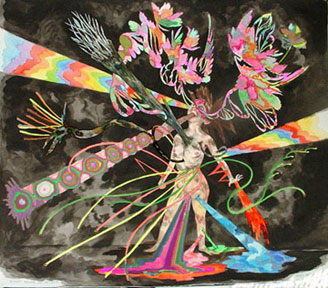 . .
. . . . . . . . . . . . . . . .
. .
. . . . . . . . . . . . . . . .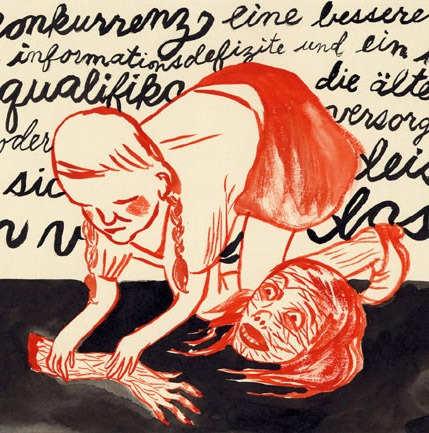
Fig. 3: Bloodie Writes an Anthem. ink, watercolour (Boyle, 2005). .
. . . . . . . . . . . . . . . . . . . .Fig. 4: untitled. ink (Boyle, 2000).
With Boyle’s work we see a move from a female subject who struggles within
the representational limits of the symbolic order ("Language defines things
in a way that I’m not personally comfortable with because it’s too
limiting" [Boyle, 2000]) , whose desire struggles within the restraints
of being the amputated other, who struggles with the castration complex and
the mark of difference as a loss, to a female subject reveling in her unceasing
fluid explosive desire. Ultimately, the female subject of her work rebels and
completes herself through this resistance, creating her own world of and through
transgression and conjoined affective sensations with nature itself; it is not
a real world because it is a work of fiction, but fiction itself is
the place of the uncanny where nothing is real yet all things are possible.
As with Elizabeth Grosz’s estimation of the writings of Irigaray and Kristeva,
Boyle too affirms "the fluid, polymorphous perverse status of libidinal
drives and… evoke(s) a series of sites of bodily pleasure capable of resisting
the demands of the symbolic order" (1990: 149).
Boyle’s female figures enact their submission and restriction in a gestural space of the semiotic, Kristeva’s concept for a pre-Oedipal time and space in which flux is emergent and drives are multiple: "The semiotic is thus the rhythmic, energetic, dispersed bodily series of forces which strive to proliferate pleasures, sounds, colours, or movements experienced in the child’s body" (McAfee, 2004: 152). To add to this statement what we know of the blurring between childhood and adulthood, it is not only the child’s body that is capable of such transgression. According to Kristeva, the semiotic is constantly erupting through the symbolic order which tries to control and repress its power of expression: "the symbolic harnesses libidinal flows" (153) in a way that this imagined world without language does not, we’ll call it ‘nature’ because that is what has been constructed for us, this dichotomy between language-as-creation and nature-as-occurring-without-intervention. Her figures bear the marks of the world ‘outside’ of them, since the boundaries pitting inside against outside are no longer in force without this space of in-between. What happened to Nathaniel in The Sandman was a result of his "flows" being "harnessed".
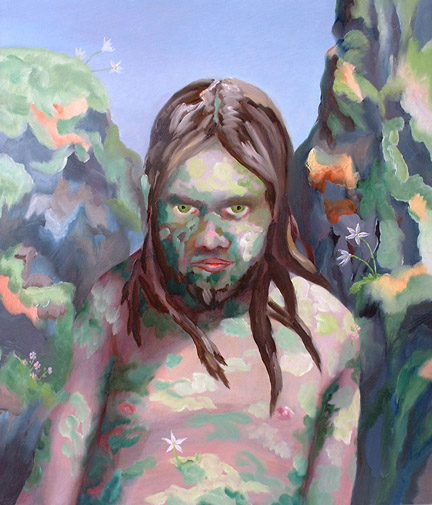 .
. . . . . . . . . . . . . . . . . . . . . . . . . . . . . .
.
. . . . . . . . . . . . . . . . . . . . . . . . . . . . . . 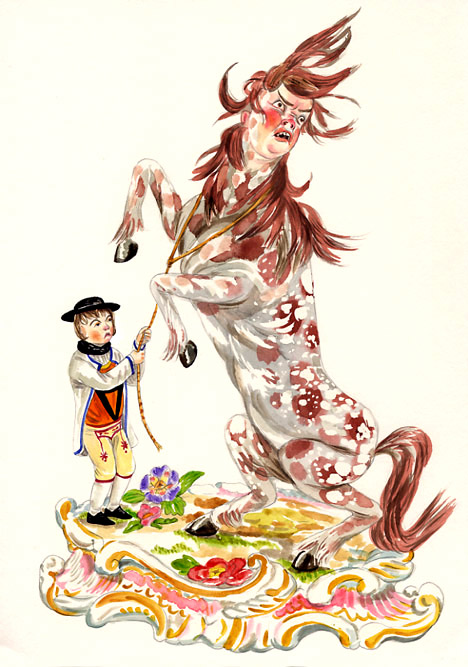
Fig. 5: Sami of Finland. oil (Boyle, 2005). . . . . . . . . . . . .
. . . . . . . . . . . . . . . . . . . . . . . . . . . Fig. 6: Porcelain
Fantasy #19. ink, watercolour (Boyle, 2005).
Kristeva believes that it is only men who can effectively disrupt the symbolic
order by semiotic expressions, but I maintain that once you have arrived at
such a possibility, it would be nihilistic and clearly futile to deny women
access to this force, since it was, in Kristeva’s estimation, from women
that such a force erupted in the first place. This brings us back to the question
of sexual difference as maintained by the symbolic order. "Sexuality, in
Freud’s understanding is not, in spite of popular conceptions, governed
by nature, instincts, or biology but by signification of meaning", writes
Kristeva (McAfee, 2004: 13). Something will mean something if we allow the signification
to occur. Following Irigaray, the distinction between the sexes is a resistance
to sameness, to assimilation, and a casting-off point for wonder: "Who
or what can move us out of mere survival except a return to the bodily-fleshly
values that have never yet come full flower" (Irigaray, 1993: 144)? We
end up once more at a space between, an uncanny place predicated on ambiguity
and questioning, on not knowing through reason alone.
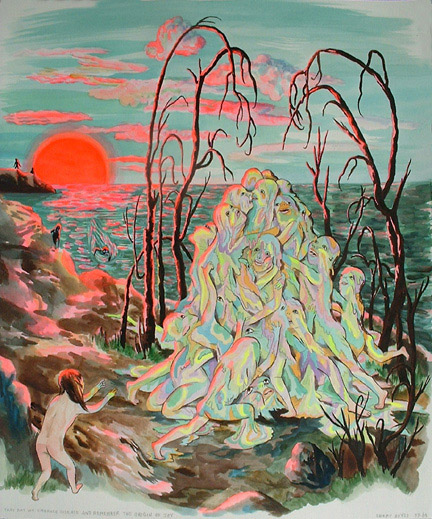 .
. . . . . . . . . . . . . . . . . . . . . . .
.
. . . . . . . . . . . . . . . . . . . . . . .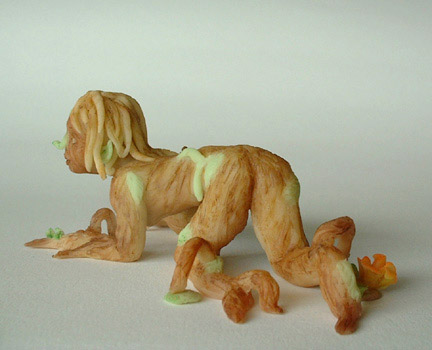
Fig. 7: The Origins of Joy. Ink, watercolour (Boyle, 2005). . . . .
. . . . . . . . . . . . . . . . . . . . . . . . Fig. 8: Taproots. Clay,
gouache (Boyle, 2005).
Magic:
Much of Shary Boyle’s work illustrates the old animistic conception of
the universe that, as a patriarchal civilization, we have supposedly surpassed.
The subjects in her work are inextricably inhabitants of such a universe. This
"over evaluation" of mental processes that allows thoughts to be empowered
within the material realm, is caught up in her visions of women and little girls
as beings with such powers, as being powerful. This narrative space is an account
of a non-Oedipal world where men are usually absent and nature itself couples
with its female inhabitants in such an animistic way as to render this universe
magical and death-defying. There is no fear of abject separation, nor of repeated
attempts to return, because one has never left; the connection between body
and the rest of the natural world is continuous, seamless, and brimming with
fluid desire that does not depend on difference for its propulsion. This fluidity
assures that death is not a loss of the self because the self, in this fiction,
was never at a loss.
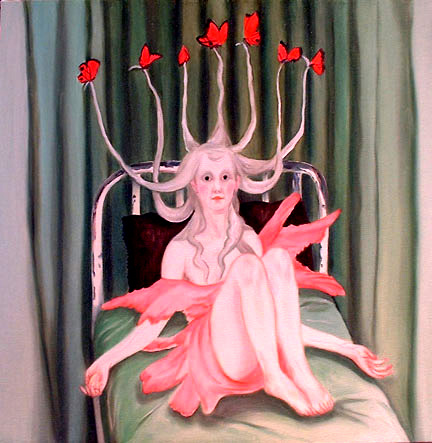 .
. . . . . . . . . . . . . . . . . . . . . . . . .
.
. . . . . . . . . . . . . . . . . . . . . . . . . 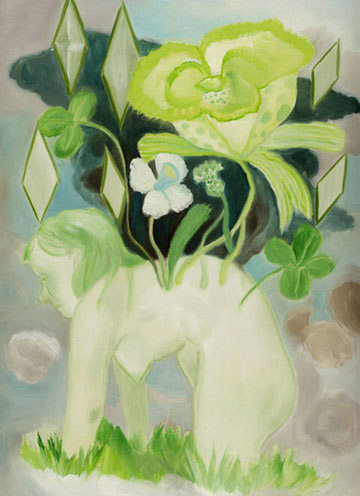
Fig. 9: unititled. Oil, fluorescent pigment (Boyle, 2003) . . . . . . . . .
. . . . . . . . . . . . . . . . . . . . . . . . Fig. 10: untitled. oil (Boyle,
2002).
This uncanny space of Boyle’s work also maintains an unabashed sexuality
that flies in the face of the symbolic order’s system of veiling and referencing.
The female sex is not covered up and no metaphoric devices are needed in her
tiny sculptures of disembodied females who are all-woman with their genitalia
exposed and flaunted; she has no need to hint at what’s there, as Lacan
did by keeping his painting by Gustave Courbet of a woman’s brazenly spread
open legs (The Origin of the World, 1866) behind a sliding door . In
this act of repression Lacan was indeed obeying the laws of the symbolic father
in covering up the very origin of the world that is the impetus for the return
of the repressed, the uncanny itself. In contrast, Shary Boyle obeys no such
laws; she is not the "dutiful daughter" who needs to maintain her
signification as dictated by the patriarchal system, rather she creates her
own system in the transgressive acts of "bringing to light" what has
been in the dark for so long. In illuminating this source of life and death
she uses visual artwork, and our affective responses to it, to highlight the
possibilities of the space-between our actions and our desires. Everything that
ought to have remained hidden and secret has become unabashedly visible in her
dreamworld of free-flowing desire and abjected sexual difference. She can do
this by brave leaps of the artistic imagination that has access to the unconscious:
As a Reserve of the Repressed, fiction is finally that which resists analysis and, thus, it attracts the most. This "freedom of fiction" as another form of the unheimliche is like that which should have remained hidden. Still this fiction does not escape the law of representation, and is mysterious to everything but itself (Cixous, 1975: 547).
. . . . . . . . . . . . . . . . . . . . . . . . . . . . 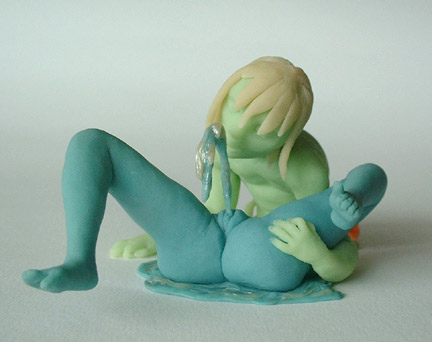
. . . . . . . . . . . . . . . . . . . . . . . . . . . . . Fig. 11: Water and Grass. Polymar clay, gouache (Boyle, 2005).
Let us take the following quotation by Freud regarding art and replace each
instance of the word "man", "he", "his" or "men"
with the feminine and read it thus:
art... brings about a reconciliation of the two principles (pleasure and reality) in a peculiar way. An artist is originally a woman who turns away from reality because she cannot come to turns with the renunciation of instinctual satisfaction which it at first demands, and who allows her erotic and ambitious wishes full play in the life of phantasy. She finds the way back to reality, however, from this world of phantasy by making use of her special gifts to mould her phantasies into truths of a new kind, which are valued by women as precious reflections of reality. Thus in a certain fashion she actually becomes the hero, the king, the creator, or the favourite she desired to be, without following the long, roundabout path of making real alterations in the external world. But she can only achieve this because other women feel the same dissatisfaction as she does with the renunciation demanded by reality, and because that dissatisfaction, which results from the replacement of the pleasure-principle by the reality principle, is itself part of reality (Freud, 1911: 224).
The symbolic order, within which the castration complex functions, may be the
way things are but when we come to fiction – when we come to Art –
we are in a fuller realm that may offer us things as they can be imagined to
be, as they can be dreamt; the world as occupied by itself and with itself in
a fluid exchange beyond threat and in awe of exhilaration: "it does not
have to be this way", is the plea of the artist in creating uncanny spaces.
In trying to sort out the uncanny through Freud and Boyle, I have ended up here,
in this space between, filled with contradictions and, therefore, spottings
of possibility.
If man achieves autonomy from a maternal that supports him,
from the kind of all-powerful Other that is finally extrapolated into God, then
perhaps he will discover that there is something inhering in the female that
is not maternal… which would oblige man – humanity – to glimpse
something other, something not of his world… not built to his specifications
(Irigaray, 1993: 145–6).
. . . . . . . . . . . . . . . . . . . . . . . . .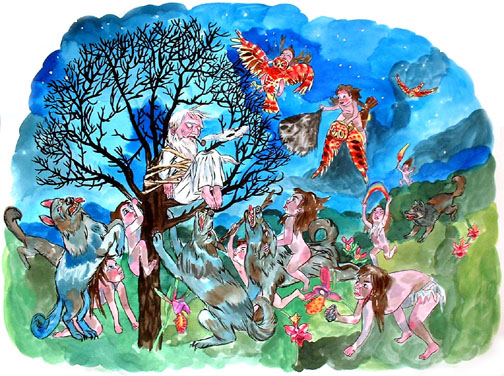
. . . . . . . . . . . . . . . . . . . . . . . . . . . . Fig.
12: Feral Girls Hunt Down and Prepare to Slay God. Ink (Boyle, 2004).
Notes:
1. These photographs were subsequently meticulously drawn in charcoal and graphite by the artist Robert Longo and exhibited at Metro Pictures, NYC for the first time in 2001, and then published in book form. http://www.metropicturesgallery.com/index.php?mode=exhibition&object_id=33
2. Peeping Tom is the name of a famous film by Michael Powell made
in 1960. The film tells the story of a cameraman who, as a young boy, was the
subject of effects-of-fear experiments by his father, who ends up a serial killer
who films his murder victims as he’s terrorizing and killing them. http://www.screenonline.org.uk/film/id/447463/
3. Olympia (1863), the at-the-time highly controversial painting by
Edouard Manet of the naked woman who looks back at us, challenging our look
of possession. We are no longer a voyeur if she knows she’s being watched,
if she’s looking back, returning the gaze. The painting was scandalous
at the time because it portrays an assertive prostitute rather than an historical
figure, as well as because of the noticeable brushstrokes and harsh light. See:
http://www.unc.edu/~sfox/olympia.html
4. Originally published in the bookwork: I Feel Funny Mommy, now published
in the book of Boyle’s bookworks Witness
My Shame, 2005.
5. This Shary Boyle quote was taken from an interview with Ryan Bigge published
in Broken Pencil, Winter 2000, and retrieved from http://www.biggeworld.com/archive/boyle.html
on 1/18/2006.
6. Jacques Lacan kept Gustave Courbet’s realistic painting L’Origine
du Monde (1866), which depicts a reclining bare-bottomed female figure
(you look at her from the point of view between her legs looking up at her genitals,
legs spread, breasts exposed, a blanket covering her face) behind a wooden sliding
door that has an abstraction of it on the front. See: http://www.lacan.com/courbet.htm.
References:
Arnzen, Michael (1997), "The Return of the Uncanny", Paradoxa,
vol 3, no 3–4, viewed 21 March 2006, <http://paradoxa.com/excerpts/3–3intro.htm>.
Barthes, Roland (1982) Camera Lucida: Reflections on Photography. Trans.
Richard Howard. New York: Farrar, Strauss and Giroux.
Bataille, Georges (1949), "The Cruel Practice of Art", viewed 21 March
2006, <www.sauer-thompson.com/essays/BatailleCruelPractice.pdf>.
Bertens, Hans (1995) The Idea of the Postmodern. New York: Routledge.
Cadava, Eduardo (1997) Words of Light: Theses on the Photography of History.
Princeton, NJ: Princeton University Press.
Cixous, Hélène (1975) "Fiction and Its Phantasms: A Reading
of Freud’s Das Unheimlich", In New Literacy History 7(3):
pp. 525-548.
Demeulenaere, Alex (2003), "An Uncanny Thinker: Michel de Certeau",
Image & Narrative, vol 5, viewed 21 March 2006, <http://www.imageandnarrative.be/uncanny/alexdemeulenaere.htm>.
Dimock, George (1994) "The Pictures Over Freud’s Couch", In
Mike Bal and Inge E. Boer (eds) The Point of Theory: Practices of Cultural
Analysis, pp. Holland: Amsterdam University Press.
Felman, Shoshana (1987) Jacques Lacan and the Adventure of Insight.
Cambridge, Mass: Harvard University Press.
Freud, Sigmund (1933) "Anxiety and Instinctual Life", In James Strachey
(trans) New Introductory Lectures on Psychoanalysis, pp. 81–111.
New York: W. W. Norton & Company.
Freud, Sigmund (1955/1911) "Formulations Regarding the Two Principles of
Mental Functioning", In James Strachey (trans) The Standard Edition
of the Complete Psychological Works of Sigmund Freud Vol. XII. London:
Hogarth Press.
Freud, Sigmund (1955/1919) "das Unheimlich".
Gallop, Jane (1988) Thinking Through the Body. New York: Columbia University
Press.
Grosz, Elizabeth (1990) Jacques Lacan: A Feminist Introduction. New
York: Routledge.
Irigaray, Luce (1993) An Ethics of Sexual Difference. Ithaca, NY: Cornell
University Press.
Kofman, Sarah (1988) The Childhood of Art: An Interpretation of Freud’s
Aesthetics. New York: Columbia University Press.
McAfee, Noëlle (2004) Julia Kristeva. NewYork: Routledge.
Salecl, Renata (1997) "The Sirens of Female Jouissance", Differences
9 (Spring): 14–35.
Sontag, Susan (1973) On Photography. New York: Bantam Doubleday.
Virilio, Paul (1989) War and Cinema: The Logistics of Perception. New
York: Verso.
Virilio, Paul (1991) The Aesthetics of Disappearance. New York: Semiotext.
Figures:
Fig. 1: Boyle, Shary (2002).
Untitled. Polymar clay, gouache. Retrieved 3 March 2006, <http://www.sharyboyle.com>.
Fig. 2: Boyle, Shary (1999). Untitled, ink. I Feel Funny Mommy. Self-published
booklet.
Fig. 3: Boyle, Shary (2005). Bloodie Writes an Anthem. Ink, watercolour.
Retrieved 3 March 2006, <http://www.sharyboyle.com>.
Fig. 4: Boyle, Shary (2000). Untitled, ink. Retrieved 3 March 2006, <http://www.sharyboyle.com>.
Fig. 5: Boyle, Shary (2005). Sami of Finland. Oil. Retrieved 3 March
2006, <http://www.sharyboyle.com>.
Fig. 6: Boyle, Shary (2005). Porcelain Fantasy #19. Ink, watercolour.
Retrieved 3 March 2006, <http://www.sharyboyle.com>.
Fig. 7: Boyle, Shary (2005).The Origins of Joy. Ink, watercolour. Retrieved
3 March 2006, <http://www.sharyboyle.com>.
Fig. 8: Boyle, Shary (2005).Taproots. Clay, gouache. Retrieved 3 March
2006, <http://www.sharyboyle.com>.
Fig. 9: Boyle, Shary (2003). Unititled. Oil, fluorescent pigment. Retrieved
3 March 2006, <http://www.sharyboyle.com>.
Fig. 10: Boyle, Shary (2002). Untitled. Oil. Retrieved 3 March 2006, <http://www.sharyboyle.com>.
Fig. 11: Boyle, Shary (2005). Water and Grass. Polymar clay, gouache.
Retrieved 3 March 2006, <http://www.sharyboyle.com>.
Fig. 12: Boyle, Shary (2004). Feral Girls Hunt Down and Prepare to Slay
God. Ink. Retrieved 3 March 2006, <http://www.sharyboyle.com>.
* All images used with permission of the artist Shary Boyle.
all rights reserved. gayle gorman. ggorman@ualberta.ca